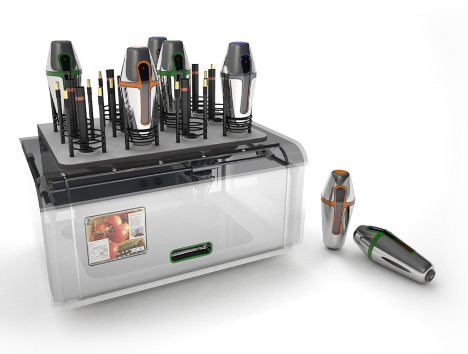
Last evening I particpated remotely from my home in France in a pre-event in Amsterdam of ElectroSmog International Festival for Sustainable Immobility.
I didn't use the fancy gadget in the photo above. My set-up yesterday was a bit, but not a lot, better-organized than the remote recording session (below) I did for a BBC radio programme last summer.

I said my bit to deBalie via skype, and followed the rest of proceedings, which were chaired by Eric Kluitenberg, on deBalie's livestreaming feed.
The deBalie session was not, I know, a major event in the greater context of events concerning sustainability, media, and design. But I'm proud, nonetheless: I have not yet set foot in an aeroplane in 2010, and this event was a meaningful first step: it followed a new year resolution radically to reduce my work-related travel.
In preparing for yesterday's modest exercise, I was amazed to discover that I have been writing about the substitution of telepresence for mobility for seventeen years. Writing, not doing, I know: By no means all my texts and talks are here and here and here and here and here and here and here and here and here and here and here and here and here and here and here and here.
Although deBalie's streaming video feed was clear (thanks to their industrial-quality cameras; three-times normal bandwidth; something called an h264 video codec; and Gerbrand); and Eric was a clear and well-organized compere; but the experience was as unrelaxing, experientially, as always.
I spent half-a-day spent fidding with lights and backdrops at my end. I had to miss lunch in order to test skype. And I had to work hard, during the event itself, to keep track of what was happening in Amsterdam. An abruptly broken connection, internet-side, just as the final Q+A started, was an abrupt but unsurprising conclusion.
Content-wise, the session was a blast from the past - in good ways and bad.
A guy from IBM demo'd a hideous virtual "creative office" populated by avatars. The avatar representing the IBM-er in Belgium failed to speak or move for five minutes; its human owner had apparently left his desk to look for a beer. This was fair enough -a national beer strike in Belgium has only recently ended - but the jerky, implausible look-and-feel of IBM's virtual office was less enticing than the pre-Sims demo given by Will Wright at Doors of Perception back in 1998.
(It wasn't much better, either, than the time I did a video conference with Korea in which twelve corporate persons - not from IBM - sat in a row facing the camera. I was able scan the camera along the line, jerkily, from my end. But because my fellow videoconferencers were dressed in identical blue suits, white shirt and dark tie; and because most of them seemed to be called Mr Kim; I soon gave up).
(But last night's IBM demo was superior to the videoconference between a summer school in Lisbon, and the White House, that I experienced last summer. Then, the link was enabled by Cisco Systems' ultra high-end platform. We were all excited because our interviewee was said to have an office just down the hall from the Oval Office. We all assumed that communicating with the centre of world power on the world's fanciest videoconferencing platform would be fab. But the link, once opened, yielded sound and pictures worse then the ones sent back by the first lunar lander. After ten minutes of torture, someone in Lisbon put their hand up and said" "can't we use skype?" - so we we did).
But there were delights, last evening, too. Costas Bissas from DistanceLab told us, from a location somewhere in the wilds of Scotland, about a cow called Grace who has been fitted with a webcam.

It took me back to the time Bill Gaver and Tony Dunne attached web-enabled microphones to chickens in Peccioli.
I told Costas I would pay good money to see Grace charging a bunch of tourists, but he said that is not their business model.
As last night's discussion continued, I had an epiphany: it is not my job to keep track of all these tele-tools and platforms - still less, to set them up and make them work when I need them.
I thought back to the early years of the telephone: for decades after the telephone was first publicly deployed, one would pick up the receiver - and a room full of operators would make the connection for you.

This is what we need now. We need the equivalent of a roadie for telepresence events.

Rock stars don't have to fiddle about setting up amps and lighting and the stage before they perform - so why should I, or any other right thinking citizen who has a life to lead?
e-Roadies are the solution I have been searching for for seventeen years.
I haven't worked out where to find them, nor how to train them - still less, a business model to pay for them. But I am surely on the right track because E-Roadies are a human solution.
Posted by John Thackara at January 22, 2010 10:35 AM
-----
Via Doors of Perception

 From 2005 up through 2008, virtual worlds seemed like the
From 2005 up through 2008, virtual worlds seemed like the 










